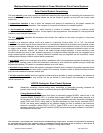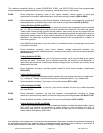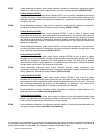
Medicare Reimbursement Guide for Power Wheelchair Drive Control Systems
Drive Control System Terminology
The term interface in the code narrative and definitions describes the mechanism for controlling the movement of a
power wheelchair. Examples of interfaces include, but are not limited to, joystick, sip and puff, chin control, head
control, etc.
A proportional interface
is one in which the direction and amount of movement by the patient controls the
direction and speed of the wheelchair. One example of a proportional interface is a standard joystick.
A non-proportional interface
is one, which involves a number of switches. Selecting a particular switch
determines the direction of the wheelchair, but the speed is pre-programmed. One example of a non-proportional
interface is a sip-and-puff mechanism.
The term controller
describes the electronics that connect the interface to the motor and gears in the power
wheelchair base.
A switch is an electronic device, which turns power to a particular function either "on" or "off". The external
component of a switch may be either mechanical or non-mechanical. Mechanical switches involve physical contact
in order to be activated. Examples of the external components of mechanical switches include, but are not limited
to, toggle, button, ribbon, etc. Examples of the external components of non-mechanical switches include, but are
not limited to, proximity, infrared, etc. Some of the codes include multiple switches. In those situations, each
functional switch may have its own external component or multiple functional switches may be integrated into a
single external switch component or multiple functional switches may be integrated into the wheelchair control
interface without having a distinct external switch component.
A stop switch
allows for an emergency stop when a wheelchair with a non-proportional interface is operating in the
latched mode. (Latched mode is when the wheelchair continues to move without the patient having to continually
activate the interface.) This switch is sometimes referred to as a kill switch.
A direction change switch allows the patient to change the direction that is controlled by another separate switch
or by a mechanical proportional head control interface. For example, it allows a switch to initiate forward movement
one time and backward movement another time.
A function selection switch
allows the patient to determine what operation is being controlled by the interface at
any particular time. Operations may include, but are not limited to, drive forward, drive backward, tilt forward,
recline backward, etc.
HCPCS Coding for Drive Control Systems
E1028 Wheelchair accessory, manual swing away, retractable or removable mounting hardware for
joystick, other control interface or positioning accessory ($175.56 to 206.28)
Coding Guideline (E1028)
Code E1028 is used for hardware that allows a cushioned headrest (E0955), lateral trunk or hip
supports (E0956, E1025-E1027), or a medial thigh support (E0957) to swing away manually or to
be removed. Code E1028 is also used for swing away hardware used with interfaces described by
codes E2320 and E2321, swing away or flip-down hardware for head control interfaces E2327-
E2330, and swing away hardware for an indicator display box that is related to the multi-motor
electronic connection codes E2310 or E2311. Code E1028 is not to be used for swing away
hardware used with a sip and puff interface (E2325) because swing away hardware is included in
the allowance for that code.
This information is not intended to be, nor should it be considered billing or legal advice. Providers are responsible for determining
the appropriate billing codes when submitting claims to the Medicare Program and should consult an attorney or other advisor to
discuss specific situations in further detail. This information is subject to change without notice.
© 2004 Invacare Corporation Page 1 of 3 Rev. 03/04 JHS





